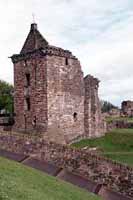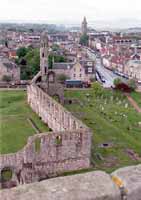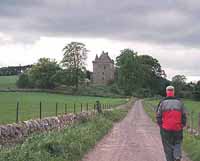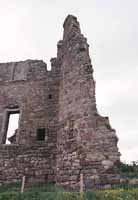
S c o t l a n d
d a y 1 1
Travel Home
Travelogue
Planning
Resources
Itinerary
Scottish Castles
Abbeys and Kirks
Other sights
email Phouka
t u e s d a y m a y 2 5 1 9 9 9
We headed off in search of a place to do laundry in St. Andrews. We had reached the stinky stage where everything we had to wear had already been worn 2 or 3 times and only rinsed in the sink betweentimes.Admittedly, we're probably not going to offend anyone but ourselves, but a clean pair of jeans is going to get very important in another day. You can clean underwear in the sink, but jeans are another matter. Euw.
After a fruitless search for a launderette, we went to the dry cleaners, who gave us directions to a DIY launderette on the other end of town. No luck finding it -- we went back and asked at the greengrocers. The wonderful young couple actually found us a map and told us exactly where to find one. On try more, and lo-and-behold, the launderette! The woman inside instructed us to leave the laundry for £7.50 per load. at this point, we wouldn't have balked if it was £20. Oh, for clean clothes!
 Divested of our stinky laundry, we drove across town to see the Cathedral of St. Andrews and St. Andrews Castle. It started to rain, and we ended up parked in front of a public toilet (always ask for a 'toilet' here, or a loo -- bathrooms are for washing, and you're likely to get blank stares if you ask for one) in what I am convinced is a no-parking zone. Mark assures me that the won't boot or tow the car. Ok...
Divested of our stinky laundry, we drove across town to see the Cathedral of St. Andrews and St. Andrews Castle. It started to rain, and we ended up parked in front of a public toilet (always ask for a 'toilet' here, or a loo -- bathrooms are for washing, and you're likely to get blank stares if you ask for one) in what I am convinced is a no-parking zone. Mark assures me that the won't boot or tow the car. Ok...
The castle is small and quite unremarkable except for two things: there is a swimming pool (yes, a swimming pool) and a mine/countermine tunnel beneath the walls. I'm still amazed at the swimming pool (a 'sunning pool' as far as we can tell). The castle, which was a bishop's residence until they killed him in it and hung him naked from the battlements, sits on the seashore, literally on the rocky crags that have fallen into the sea. Indeed, some of the walls of the castle have fallen into the water, leaving doorways and half-stairs on the cliff face over the beach. At high tide, the water probably laps at the remaining walls.
Back to the pool. Right off the beach is a large area sort of walled off with a short stone wall, rectangular in shape, and running right up on the sand. It's no more than a few feet deep at the end. At high tide, it's submerged and flushed out. At low tide, the stone wall is above the water level and holds a shallow pool. It would even get warm by the end of the day. It looks like the castle probably had a staircase or walkway all the way down to the beach just for this pool, which might have been used for washing or bathing.
The mine/countermine were dug when the castle was besieged, and was discovered when they were excavating for a house across the street in the 1870s. The attackers dug a tunnel heading for the wall. Inside, they tried to gauge where the tunnel was, and dug their own to meet it. There are two false starts, very deep holes, and a final tunnel in he castle grounds that is a small, low tunnel. It branches once -- they must have heard something -- and finally, some 30' along the tunnel, they miraculously met the other tunnel. Pure luck, and good ears. It had to be. The hole is barely large enough to crawl through, but opens to a good sized chamber where they fought before the defenders won. Mark clambered down the hole -- I stood in the damp, dripping cave asking him to beep so I knew he was ok.
 It starts to pour as we walked to the Cathedral. We decided to wait it out in the car. It only lasted a few minutes. It's a gray day out, but certainly not unpleasant. The weather here has been amazing.
It starts to pour as we walked to the Cathedral. We decided to wait it out in the car. It only lasted a few minutes. It's a gray day out, but certainly not unpleasant. The weather here has been amazing.
The Cathedral is enormous. Mark paced it off as 400' x 70' at the smallest points. Only half of the end of the nave is still standing, and the east gable. Only one exterior wall remains. The windows change from a tall, narrow pointed Gothic arch near the center of the church to the rounded Norman arches by the end of the wall. Given that these churches were built over decades, the style certainly changed, or they changed their minds. The scale is impressive even if the cathedral was rather plain. It was the largest cathedral in Scotland.
In the churchyard stands St. Rule's Tower. It's a simple square tower with a gallery on the top -- up five stories. Once again, up ten flights of stairs...the view over St. Andrews is stupendous. St. Andrew's is a pretty town, and you can see the castle and the greens of the famous golf courses from up here. Someone left pancakes on the top of the tower. I wonder why?
Picked up laundry! Yeah!
We spent a bit of time in "lost" today. But we ended up by Hill of Tarvit House while looking for the keys for Scotstarvit Tower. Hill of Tarvit House is a turn of the century home that is in almost pristine condition. It was willed in it's entirety to the National Trust, who maintains it as a museum-piece. The Starks were avid collectors and a lifetime of collecting is housed here. Everything is labelled 'do not touch', so it's a bit stuffy. But they have staff in every room to tell you about the room, and nothing is behind ropes. In the Lady's Bedroom (she lived there until 1948 or so, when she willed the house to her daughter, who died unmarried in 1950) the ceiling is a perfectly smooth, perfectly shaped sphere. If you stand directly under it, you get the most bizarre echo effect, like you are amplified. The other bedroom is oval, with the same perfectly smooth spherical ceiling. One of the focus points is near the settee, and the other directly over the bed. Must make for interesting conversations! It's a very liveable house, though, for all it's a museum. It's apparent that it was lived in and used as a family home for many years.
 We got the key to Scotstarvit, another 15th century tower house, and walked all the way over. I am going to be the only person who loses weight on vacation! We unlocked the door and walked into the best towerhouse that we've been in. It was renovated in the 1880s or so, and still remains in nearly livable condition -- minus a few floors, obviously. There are windows in all the openings, the stairs are solid and the floors that do exist are solid and well maintained.
We got the key to Scotstarvit, another 15th century tower house, and walked all the way over. I am going to be the only person who loses weight on vacation! We unlocked the door and walked into the best towerhouse that we've been in. It was renovated in the 1880s or so, and still remains in nearly livable condition -- minus a few floors, obviously. There are windows in all the openings, the stairs are solid and the floors that do exist are solid and well maintained.
The tower sits on the back corner of someone's property -- you have to walk by their kitchen window to get to the tower.
Mark decided he wanted to see "Scotland's Secret Bunker", a recently declassified nuclear bunker. It was back up near St. Andrews, so we raced off to find it. We spent a lot of time in lost again... and found this place about 5 minutes before it closed. Mark got their brochure, and we figured we'd go back -- until re realized it didn't open until 10:00 the next morning.
I had wanted to go to Falkland Palace, but it was way too far to attempt tonight. We ended up in the gardens at Kellie Castle. Amazing. Formal gardens off rose arbors, climbing vines, perennials, and even veggies. All laid out in careful patterns edged with lavender hedges. It's going to be stunning when it is in full bloom. I don't think the pictures will do it justice. It was the work of a single family for many years, before being handed over to Historic Scotland. We didn't get into the castle, since it closed just before we arrived. It is another 'museum' piece, so we walked around the outside and took pictures, but didn't worry to m much about going inside.
 We had scheduled dinner for 8:30, since Ms. Anderson was going into Aberdeen by train and wouldn't be back. So we drove back down the coastal path and stopped in at Newark Castle and walked through another windy field to see it, perched on the rocks over the beach. The pictures in the castle book show that quite a bit of the castle walls have fallen very recently, and the ruin is marked as dangerous. We scrambled down the hill to get some pictures, but even Mark didn't venture inside for very long. Honestly, I figure that these things have been standing for hundreds of years, the chances that one will decide to choose this moment to fall are quite small. I hope.
We had scheduled dinner for 8:30, since Ms. Anderson was going into Aberdeen by train and wouldn't be back. So we drove back down the coastal path and stopped in at Newark Castle and walked through another windy field to see it, perched on the rocks over the beach. The pictures in the castle book show that quite a bit of the castle walls have fallen very recently, and the ruin is marked as dangerous. We scrambled down the hill to get some pictures, but even Mark didn't venture inside for very long. Honestly, I figure that these things have been standing for hundreds of years, the chances that one will decide to choose this moment to fall are quite small. I hope.
We stopped in Crail, which is a fishing village north of Newark. Very stinky. As far as we can tell, they pump their raw sewage into the bay, and at low tide the end of the pipe is not to far into the water. It certainly smells like it, anyway. I'm so glad that we didn't try to stay here. The smell was honestly enough to gag you.
Down from Crail, we drove through Anstruther, Pittenweem, St. Monans. We saw a windmill, of all things, in the distance, but I didn't want to walk all the way down to see it. We did see a whole bunch of dovecotes, though, on the drive. Dovecotes were very important to castles -- not for messages as you might imagine, but for meat. A goodly supply of squabs could be produced with little effort in these rectangular or beehive shaped buildings. They could often house a thousand pairs of birds.
Dinner was later than expected, due to problems with the train service from Aberdeen, but it was delicious. We drank the three bottles of Mead that we bought from Dryburgh Abbey.
©1999-2001 R. Fingerson
I t i n e r a r y a n d
P h o t o g r a p h s
st andrews
st andrews castle
st andrews cathedral
st rule's tower
hill of tarvit house
scotstarvit tower
scotland's secret bunker
kellie castle
newark castle
l o d g i n g
beaumont lodge
43 Pittenween Rd
Anstruther, Fife
KY10 3DT
01333 310315